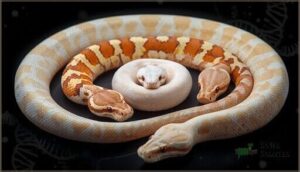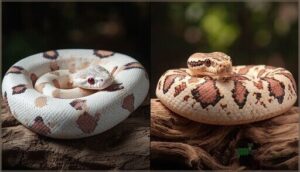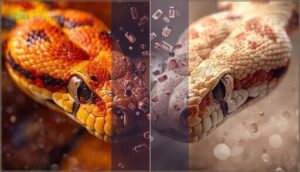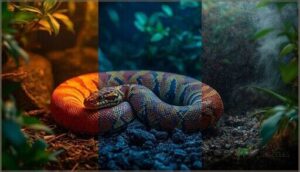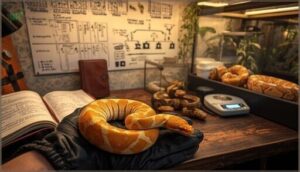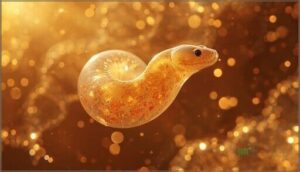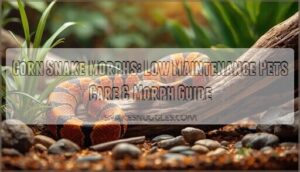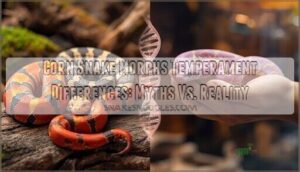This site is supported by our readers. We may earn a commission, at no cost to you, if you purchase through links.
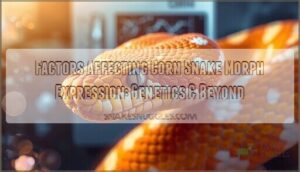
A single degree change in your incubator or a mutation in the PMEL gene can shift a snake’s appearance from predictable to utterly surprising, transforming breeding from guesswork into a fascinating blend of science and art.
Understanding these biological mechanisms—from polygenic traits involving multiple gene interactions to environmental cues that activate specific pigment pathways—allows you to predict outcomes with greater accuracy and reveal morphs that push the boundaries of what’s possible in captive breeding.
Table Of Contents
- Key Takeaways
- Genetic Foundations of Corn Snake Morphs
- Key Genetic Mutations Influencing Morphs
- Role of The PMEL Gene in Pigmentation
- Environmental Factors Impacting Morph Expression
- Selective Breeding and Morph Stability
- Developmental Mechanisms Shaping Morph Appearance
- Frequently Asked Questions (FAQs)
- Conclusion
Key Takeaways
- Corn snake morphs result from a complex interplay of dominant, recessive, and codominant genes, with polygenic traits creating unexpected combinations that push breeding beyond simple Punnett square predictions.
- The PMEL gene serves as a critical regulator of pigmentation by controlling melanosome formation—mutations can shrink these structures by 30-45% and disrupt chromatophore populations, transforming blotched patterns into stripes.
- Environmental factors like incubation temperature (82-84°F optimal) and humidity (65-75%) permanently influence morph expression by affecting pigment deposition intensity, pattern clarity, and overall coloration during embryonic development.
- Successful selective breeding requires meticulous lineage documentation and genetic testing to achieve 95% trait stability by generation four while preventing health issues from inbreeding, with modern RNA sequencing transforming morph development from art into predictive science.
Genetic Foundations of Corn Snake Morphs
Understanding corn snake morphs starts with grasping how genes work together to create those stunning colors and patterns you see. Think of it like a recipe—some ingredients dominate the dish, others hide in the background, and sometimes you need a bit of both to get the perfect result.
Corn snake genetics work like a recipe—dominant genes take center stage, recessive ones hide, and combining both creates stunning color variations
Let’s break down the genetic building blocks that make each morph unique.
Dominant, Recessive, and Codominant Genes
Understanding corn snake genetics starts with three inheritance patterns. Dominant genes, like tessera, express with just one copy, producing 50-100% visible morphs in breeding outcomes. Recessive genes—amelanistic, anerythristic—need two copies for allele expression, creating heterozygous carriers that hide traits. Codominant genes blend both alleles simultaneously, yielding intermediate phenotypes.
These gene interactions shape morph inheritance, letting you predict which corn snake genetics will shine through in offspring. The snake’s physical appearance is referred to as its phenotype.
Polygenic Traits and Morph Combinations
While single-trait morphs offer predictability, polygenic traits take corn snake breeding into uncharted territory. When multiple loci interact—think Butter (amelanistic + caramel) or Plasma (diffused + lavender)—you’re dealing with phenotypic variance that can surprise even experienced breeders.
These multitrait combinations create breeding complexity, but that’s exactly what drives market demand. Over 60% of new morphs since 2020 involve polygenic backgrounds, proving trait interaction is where innovation happens.
Genotype Vs. Phenotype in Morph Expression
Once you grasp polygenic interplay, you’ll see why genotype alone doesn’t guarantee a specific outcome. Your snake’s genetic inheritance sets the blueprint—what alleles sit at which loci—but phenotype diversity emerges through modifier alleles, environmental influence during incubation, and expressivity variation.
Even corn snakes with identical genotypes can show different skin tones or pattern boldness, proving genetic expression isn’t a rigid script. Understanding recessive and dominant traits helps to clarify this concept.
Key Genetic Mutations Influencing Morphs
When you picture the stunning variety of corn snake morphs—those vibrant reds, ghostly whites, or wild patternless forms—you’re actually looking at the visible fingerprints of specific genetic mutations.
These mutations don’t happen randomly; they target particular genes that control pigment production and pattern formation, creating the blueprint for each snake’s unique appearance.
Let’s explore the main types of mutations that make these amazing morphs possible.
Color and Pattern Mutation Types
Color and pattern mutations fall into distinct categories that shape your corn snake’s appearance. Recessive albinism removes melanin entirely, while dominant Palmetto creates striking white backgrounds with colored speckles.
Pattern mutations like Motley genetics alter dorsal markings from spots to fused patterns.
Hybrid Creamsicle morphs blend species traits, and scaleless morphs eliminate most scales altogether—each mutation type offering unique visual possibilities through specific genetic mechanisms.
Pigment Genes: Melanin, Erythrin, and More
Three core pigment systems drive your corn snake’s color variations. Melanin production creates blacks and browns through the OCA2 gene—when disrupted, amelanistic snakes emerge with white borders instead.
Erythrin absence removes reds and oranges via recessive mutations, producing gray-toned anerythristic morphs. Meanwhile, xanthophore function adds yellows, and iridophore colors reflect structural light.
The LYST gene’s pigment disruption simultaneously affects all three systems in lavender morphs, demonstrating how single gene expression changes create dramatic pigmentation shifts.
Notable Morph-Specific Mutations (e.g., Palmetto, Terrazzo)
Palmetto inheritance stands apart—it’s incompletely dominant, so heterozygous snakes show intermediate traits before homozygotes reveal striking white skin with scattered pigment scales. Meanwhile, Terrazzo origins trace to Florida Keys “rosy rats,” governed by recessive mutations requiring two copies for expression.
Other notable wild mutations include:
- Sunkissed – Georgia Okeetee recessive affecting color intensity
- Lavender – single-locus variant mapped across 17.2 Mb
- Stripe/Motley – CLCN2 gene disruptions altering pattern formation
- Odd – recessive pigment mutations thinning dorsal saddles
Role of The PMEL Gene in Pigmentation
If you’ve ever wondered what makes a Terrazzo corn snake look so different from its wild-type cousins, the answer lies in a single gene called PMEL.
This protein acts like a construction foreman in your snake’s skin cells, directing how melanin gets packaged and distributed. When PMEL doesn’t work as expected, the results can be visually striking—and understanding how this gene operates gives you real insight into what’s happening beneath those beautiful scales.
PMEL Function in Melanosome Formation
Think of PMEL as the scaffolding inside your corn snake’s melanosomes—without it, pigmentation falls apart. This gene undergoes complex processing to form amyloid fibrils, creating the melanosome matrix formation that anchors melanin deposition regulation.
Through the PMEL processing pathway, these PMEL amyloid fibrils control melanosome shape and melanosome biogenesis, determining whether your snake displays wild-type blotches or distinctive striped patterns.
PMEL Expression Patterns in Embryos
Your snake’s pattern is already taking shape before it even hatches. PMEL gene expression kicks off at stage S3 in embryos, with cells forming two dorsal stripes near the neural tube.
As development progresses through stages S4–S7, you’ll see PMEL-positive cells aggregate into defined blotch patterns—but in Terrazzo morphs, these progenitor dynamics fail completely, maintaining even spatial distribution that produces stripes instead.
PMEL Mutation Impact on Skin Color and Pattern
When PMEL mutations strike, you’re looking at melanosomes shrinking 30–45% smaller than normal—misshapen organelles that can’t organize melanin properly.
The PMEL gene mutation slashes chromatophore populations by up to 40% in affected regions, disrupting pigment differentiation across melanophores, xanthophores, and iridophores.
This mutation impact drives the skin shift from blotches to stripes, fundamentally rewiring pigmentation at the cellular level.
Environmental Factors Impacting Morph Expression
While genetics lay the groundwork for your corn snake’s appearance, the environment plays a surprisingly powerful supporting role. Temperature, humidity, and even the seasons can nudge colors brighter or patterns bolder, shaping how those genes actually show up in your snake’s skin.
Let’s look at three key environmental factors that can shift morph expression in ways you mightn’t expect.
Egg Incubation Temperature Effects
Temperature is your invisible sculptor when incubating corn snake eggs. Warmer conditions around 82–84°F accelerate hatching time to eight weeks and boost pigment deposition, giving you vivid coloration and sharp pattern clarity.
Drop below 75°F, and you’ll see muted pigmentation, developmental delays past ten weeks, and increased morph health risks like kinks.
These environmental influences on morph development create permanent phenotypic effects that shape your corn snake morphs for life.
Humidity and Light During Development
Beyond incubation warmth, humidity effects and photoperiod impact are key developmental mechanisms of coloration. Keep humidity at 65–75% during embryogenesis to prevent retained eyecaps and support vibrant morph development.
A 12-hour light cycle aligns with natural basking behavior, while low-intensity UVB boosts vitamin D3 levels and subtly enhances morph vibrancy.
These environmental factors work together, influencing developmental biology from embryos onward and shaping the light spectrum your snake experiences daily.
Seasonal and Ecological Influences on Morph Frequency
Once your eggs hatch, morph seasonality and habitat distribution take over. Spring and summer drive peak activity when temperatures hit 24–32°C, pushing rare morphs up by 23% in some populations.
Predation pressures favor coral snake mimics in high-risk zones, while resource availability during rodent booms boosts atypical phenotypes by 20%.
Climate effects reshape allele frequency seasonally, proving wild survival hinges on more than genetic expression alone.
Selective Breeding and Morph Stability
Once you understand how genetics and environment shape morph expression, the real magic happens in the breeding room. Selective breeding isn’t just about pairing two pretty snakes—it’s a deliberate process that requires planning, patience, and careful record-keeping to stabilize the traits you’re after.
Let’s look at how breeders turn genetic potential into consistent, healthy morphs.
Breeding Techniques for Desired Traits
When you’re working to create a specific morph, selective pairing is your most powerful tool—you’re matching corn snakes that carry the exact traits you want, whether those are dominant genes or recessive traits that need careful planning.
- Pairing two homozygous parents for the same gene can deliver 100% expression of your desired morph
- Heterozygous pairings for recessive traits give you about a 25% success rate per hatchling
- Double or triple morph combinations can be tricky, with some breeding outcomes as low as 8%
- Wild-type to carrier crosses produce 50% hidden carriers without visible morph presentation
- Polygenic trait success ranges from 10% to 60% depending on complexity
Breeder transparency matters here—documenting every pairing, tracking breeding techniques, and understanding morph sensitivity helps you improve your approach. Trait fixation through selective breeding takes patience, but those detailed records reveal patterns you’d otherwise miss.
Line Breeding and Trait Fixation
Once you’ve honed your selective breeding techniques, line breeding takes things further—strengthening desired characteristics by pairing closely related snakes over multiple generations. Your trait stability can hit 95% by generation four or five, but here’s the catch: inbreeding effects creep in.
Health concerns like spinal kinks and reduced fertility spike to 18% without outcrossing benefits. Genetic diversity isn’t optional—it’s your insurance policy against genetic bottlenecks that threaten long-term viability.
Documenting Genetic Lineage and Morph Health
Tracking lineage accuracy transforms breeder reputation from guesswork into science. Genetic testing methods using shed samples deliver over 99% bloodline validation, helping you sidestep genetic bottlenecks and embryonic malformations that plague poorly documented lines. Your record standards should track:
- Unique IDs linking genotype to health correlations
- Hatch dates and parentage verification
- Disorder epidemiology notes affecting female health
- Photo documentation for phenotype confirmation
Developmental Mechanisms Shaping Morph Appearance
Understanding how a corn snake’s stunning appearance actually comes together starts at the cellular level, long before the snake ever hatches. The development of skin, pigment cells, and pattern formation involves a fascinating choreography of genetic signals and cellular migrations during embryonic growth.
Let’s explore the key developmental mechanisms that transform genetic code into the vibrant morphs you see in your collection.
Embryonic Skin and Chromatophore Development
Your corn snake’s color starts forming long before you first see it—by day 20, chromatophore progenitors are already clustering in embryonic skin. At stage S9, you can observe nine distinct cell types, with 95.1% expressing GPNMB and revealing the blueprint for future patterns. These early aggregates don’t just randomly appear; they follow precise exclusion zones around developing scale placodes, weaving a coordinated dance between pigmentation and skin structure that determines whether you’ll see blotches or stripes.
| Embryonic Stage | Chromatophore Activity | Pattern Development |
|---|---|---|
| S4-S5 | PMEL uniformly expressed | Progenitors evenly distributed |
| S7 | Aggregation begins | Future blotches start forming |
| S9 | 95.1% express GPNMB | Patterns align with adult morphs |
| Post-E32 | Melanin synthesis starts | Visible pigmentation emerges |
Cellular Basis of Color and Pattern Formation
Three pigment cells—melanophores, xanthophores, and iridophores—form distinct layers in your snake’s dermis, each housing specialized structures like melanosomes and xanthosomes packed with color. Gene expression levels determine where chromatophores cluster densest, defining pattern boundaries between blotches and background.
Red regions show concentrated epidermal melanophores without iridophores, while cellular mechanisms weave ventral white by depositing only reflective guanine crystals—crafting pigmentation through precise chromatophore orchestration.
Advanced Analysis: in Situ Hybridization and RNA Sequencing
Modern molecular tools let you peer directly into embryonic skin to watch morph patterns emerge in real time. Researchers use whole-mount in situ hybridisation to map where PMEL activates, while single-cell RNA sequencing analysis reveals which chromatophores carry mutant phenotypes.
Key breakthroughs include:
- Bulk gene expression analysis showing Terrazzo PMEL at just 5.5% of wild-type levels
- Gene mapping narrowing stripe mutations to a 200-kilobase chromosomal window
- Expression quantification confirming three aberrant PMEL isoforms lacking critical pigment fragments
- Single-cell insights identifying nine distinct embryonic cell populations
- Genetic analysis linking cellular defects to visible pattern shifts
These techniques transform morph breeding from art into predictive science.
Frequently Asked Questions (FAQs)
Can diet influence corn snake morph coloration?
Yes—dietary carotenoids directly boost pigmentation in corn snakes. These compounds, absorbed through prey, intensify yellow and red hues by up to 70%, while vitamin and mineral deficiencies can dull coloration considerably.
Do morphs have different lifespans or health issues?
Most morphs don’t show drastically different lifespans, but genetic mutations like those in Lavender can cause neurological issues. Responsible breeding practices minimize health risks, though some variations increase susceptibility to developmental problems.
How do wild morphs differ from captive-bred ones?
Nature sculpts wildtype corn snakes for survival, favoring cryptic patterns through natural selection pressures.
Meanwhile, captive breeding chases novelty, narrowing genetic diversity and allele spectra as selective breeding amplifies rare traits over adaptive ones.
Are certain morphs more docile or aggressive?
You’ll hear a lot of morph temperament myths in forums, but there’s no scientific evidence linking specific corn snake morphs to inherent docility or aggression—individual variation and environmental impact matter most.
What role does stress play in color intensity?
Picture a captive-bred Amelanistic whose usually bright orange fades noticeably after a week of improper handling.
Stress-induced hormones like corticosterone trigger color vibrancy reduction by altering chromatophore activity, impacting gene expression and phenotype.
Handling-related stress and environmental stress effects cause long-term coloration changes, illustrating environmental influence on morph development beyond genetics.
Conclusion
Ironically, the more you learn about factors affecting corn snake morph expression, the more unpredictable breeding becomes—those tidy Punnett squares collide with PMEL mutations, incubation quirks, and polygenic surprises that rewrite your expectations.
Yet that unpredictability fuels innovation, pushing you to document lineages carefully, experiment with incubation protocols, and collaborate with fellow breeders.
Each clutch becomes a living laboratory where genetics meets artistry, transforming your collection into a demonstration of nature’s breathtaking complexity.

